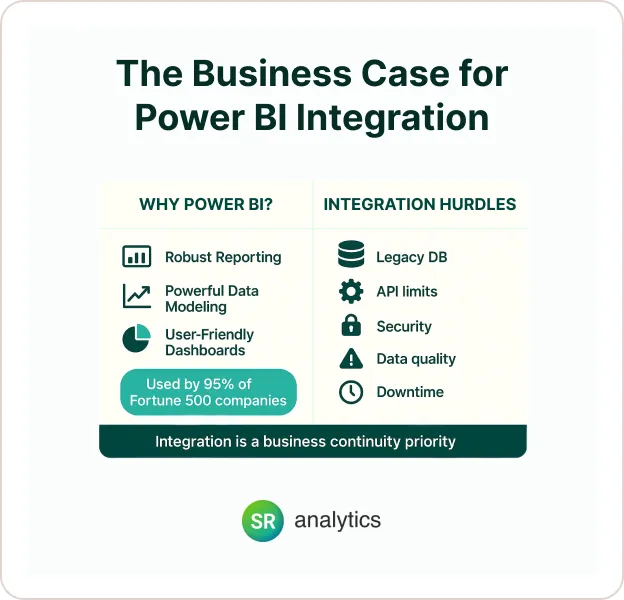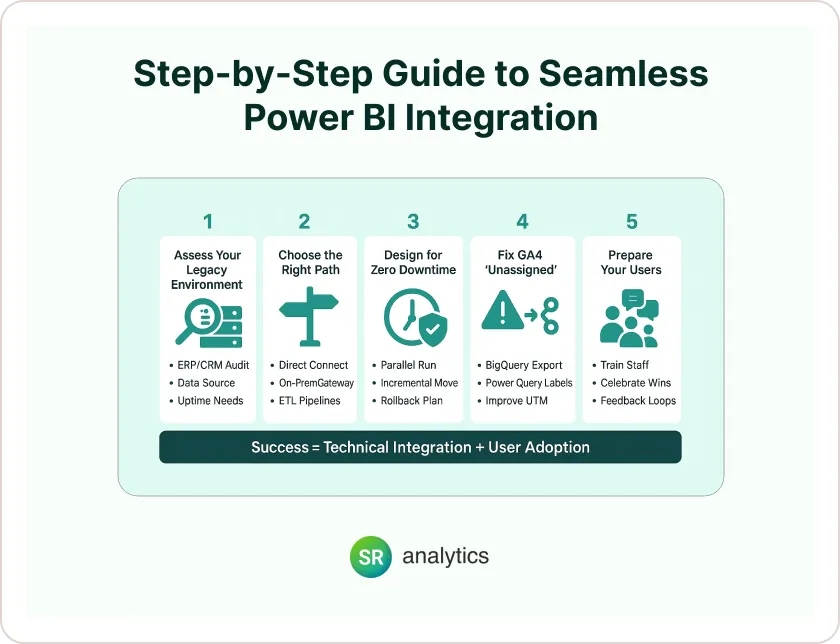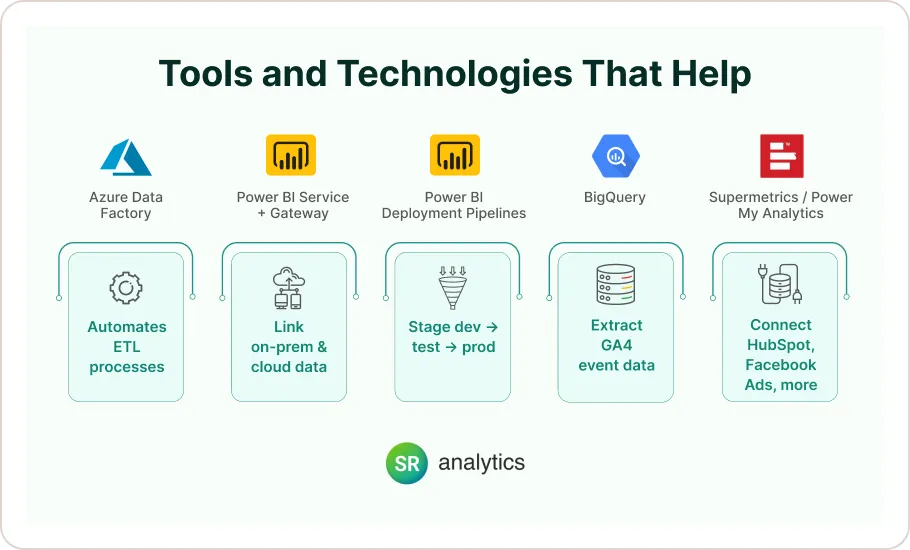Introduction
Imagine flipping the switch on your new Power BI dashboards—and your finance team doesn’t miss a single report. No angry emails. No confused managers. No data gaps.
That kind of smooth transition is possible when Power BI is integrated seamlessly, with no downtime and no disruption to legacy systems.
But let’s face it—most integrations don’t go that smoothly. You know the drill: unplanned system outages, data silos, security gaps.
It’s a headache.
We’ve all been there, dealing with last-minute firefighting instead of celebrating the new system’s potential.
This blog is for CIOs, IT leaders, and business decision-makers who are tired of vague promises and want a clear, actionable roadmap. Backed by real research, we’ll show you how to migrate or integrate Power BI into your environment without interrupting day-to-day operations—whether you’re dealing with old-school ERP systems, cloud apps, or that Frankenstein database you swear was built in the ’90s.
The Business Case for Power BI Integration

Power BI is now used by over 95% of Fortune 500 companies. Why? Because it offers robust reporting, powerful data modeling, and user-friendly dashboards that drive faster decisions.
But integration isn’t plug-and-play, especially if you’re still running on-prem systems or older business applications.
There are some significant challenges that companies face during the integration process, such as:
- Incompatible legacy databases: Many businesses still use outdated database systems that are not easily compatible with modern tools like Power BI.The issue here isn’t just about connecting the systems—it’s about making sure the data from these old systems can be leveraged for advanced reporting and analytics without jeopardizing the reliability of your business processes.
- API limitations: Power BI’s connectors work wonders for cloud applications, but what about systems that don’t have an API? In some instances, legacy systems have no straightforward method to send data to Power BI, creating a bottleneck for seamless integration.
- Security misconfigurations: Security is a critical factor when connecting multiple systems. If Power BI isn’t configured properly, sensitive business data might be exposed to unauthorized access. Without proper access controls, the risk is too high for most businesses.
- Poor data quality: Clean and accurate data is crucial for generating meaningful insights. Many businesses find that their legacy data is full of inconsistencies or inaccuracies, which complicates the integration process and leads to faulty reports.
- Downtime during data migration: Migrating data from one system to another is always a tricky process, and even a small amount of downtime can have significant consequences for businesses.Whether it’s an ERP system or a cloud database, ensuring zero downtime is essential for a smooth transition.
Addressing these challenges isn’t just a tech problem—it’s a business continuity issue. When systems are down or data is lost, your teams can’t operate efficiently, and that’s a business problem. That’s why seamless Power BI integration must be part of your digital transformation strategy.
The benefits of streamlined Power BI integration can far outweigh the initial complexities. If executed well, you’ll find that integrating Power BI into your operations not only improves business intelligence but also frees up your team’s time by automating and simplifying decision-making processes.
Integration Without Disruption: What Competitors Get Right (and Wrong)
What They Do Well
- Highlight Common Integration Pitfalls: Blogs from AlphaBOLD and ScaleupAlly do a great job surfacing challenges such as data silos, governance risks, and performance bottlenecks.These blogs bring awareness to potential problems, giving businesses the chance to proactively address them before they cause issues. Identifying these pitfalls early can save time and reduce the risk of costly mistakes later.
- Offer Structured Best Practices: Recommendations like phased rollouts, pilot testing, and real-time monitoring are frequently cited and very effective. These strategies allow for smoother integration, especially in large enterprises with complex data environments.By adopting a step-by-step approach, companies can address minor issues before they turn into significant disruptions.
- Case Studies Add Credibility: A financial services client experienced a 33% reduction in decision-making time after adopting Power BI dashboards, leading to enhanced operational efficiency.
By showcasing real-life examples, these blogs prove the tangible benefits of Power BI and help set expectations for potential clients. Case studies act as proof points, demonstrating the potential ROI that comes with successfully implementing Power BI.
Where They Fall Short
- No Clear Strategy for Zero Downtime: Few blogs explain how to implement Power BI without interrupting existing systems. They often fail to mention essential strategies like running parallel environments or scheduling off-peak deployments, which are critical for businesses that cannot afford any downtime.Power BI integration is not just about connecting the tool—it’s about making sure everything works in the background without affecting the user experience. A proper parallel run, for example, ensures that your legacy systems can continue to function while you make the necessary adjustments.
- Missing GA4 Integration Guidance: Not one blog addresses the issue of “unassigned” traffic in Google Analytics 4 (GA4), despite its increasing relevance for marketing and eCommerce analytics.If you’re relying on GA4 for tracking marketing efforts, Power BI needs to be able to integrate this data accurately, but this often goes unaddressed. Accurate GA4 integration is critical for businesses that want to harness the power of their marketing data in Power BI.
For more on setting up GA4 correctly, check out our guide to GA4 migration and data recovery in 2025.
- Lack of Legacy System Nuance: Many integration guides generalize the process without considering the specific quirks of legacy systems. Whether you’re working with SAP, Oracle, or a homegrown ERP, each system has unique challenges that require a tailored approach.It’s important to have consultants who understand the nuances of your legacy systems and can adapt Power BI integration accordingly.
- Skips Human Factors: Many blogs overlook the importance of user adoption and change management. It’s not just about the tech—it’s about getting your team on board.Tools don’t matter if your team isn’t trained or comfortable with the new systems. Without proper training and support, even the most powerful tools will not be used effectively, leading to poor adoption rates.
Step-by-Step Guide to Seamless Power BI Integration

1. Assess Your Legacy Environment
Start with a comprehensive audit:
- What systems are you currently using (ERP, CRM, custom databases)?
- What data sources will be migrated vs. connected?
- What are your uptime requirements?
If you’re working with ERP Power BI setups, this phase is especially critical. For example, a Microsoft Dynamics 365 instance behaves very differently than an aging on-prem SQL Server. If you’re migrating from on-prem to cloud solutions, understanding these differences will help you avoid migration nightmares down the road.
Taking the time to understand your current environment might seem tedious, but it’s a crucial first step. We’ve seen clients rush this phase and end up in the weeds, dealing with data discrepancies and compatibility issues later in the process. The more comprehensive your audit, the smoother the whole integration will be.
2. Choose the Right Integration Path
You have three main options:
- Direct Connection via Power BI Connectors: Best suited for cloud-based sources or modern APIs. Power BI comes with built-in connectors for a variety of modern applications, making this the most straightforward option.
- On-Premises Data Gateway: Ideal for legacy databases needing real-time access. This method keeps your on-prem data on-site but allows Power BI to pull it into the cloud for visualization.
- Data Lake or ETL Pipelines (Azure Data Factory, SSIS): Best for large volumes of data or complex transformations. If you’re working with complex data transformations, consider setting up a data lake to centralize your data and streamline the process.
Tip: For real-time dashboards using legacy ERP data, combine the On-Prem Gateway with row-level security to ensure users only see relevant data.
3. Design for Zero Downtime
Minimize disruption with these strategies:
- Parallel Run: Maintain legacy reports while building Power BI dashboards in a sandbox environment. This allows teams to keep working without feeling any impact during the integration.
- Incremental Migration: Transition one business unit or dataset at a time. This is a great approach for large enterprises where a full migration could overwhelm the system and create chaos.
- Off-Hours Deployment: Schedule data syncs or system changes during non-peak hours. By migrating outside of working hours, you reduce the risk of affecting users during critical business operations.
- Rollback Plan: Always have a way to revert to the old system if something breaks. Downtime can happen unexpectedly, so you need a safety net in place.
Having a rollback plan is often overlooked but incredibly important. If the new system doesn’t work as expected, you don’t want to risk losing access to critical reports or data. Keeping the old system running in parallel while testing the new one ensures a quick recovery if something goes wrong.
4. Address the GA4 “Unassigned” Problem
If your marketing team uses GA4, you’ve likely seen “(unassigned)” show up in your channel groupings. Here’s how to fix it when integrating with Power BI:
- Use BigQuery Export: GA4 lets you export raw data to BigQuery, which you can connect to Power BI for a deeper level of reporting.
- Transform in Power Query: Replace “(unassigned)” with meaningful labels using custom logic in Power Query. This step allows you to clean up data before it’s visualized.
- Improve UTM Tagging: Ensure marketing links use consistent UTM parameters. This will help reduce future unassigned entries and give you more accurate data.
By following these steps, your business analysts get clearer insights, and your marketing team can optimize ad spend with more precise tracking.
5. Prepare Your Users
No integration is complete without user adoption. Here’s how to prepare:
- Train End Users: Offer short workshops or recorded tutorials. These bite-sized lessons help users get up to speed without overwhelming them.
- Run Internal Campaigns: Highlight early wins from Power BI dashboards to show users the tool’s potential.
- Support Feedback Loops: Create a Slack or Teams channel for users to report issues or request changes.
Adoption is smoother when users feel involved—not blindsided. The right training and communication strategy can significantly reduce resistance to the new system.
Tools and Technologies That Help

To facilitate the seamless integration of Power BI into your existing systems, several tools and technologies can make the process smoother and more efficient.
Let’s dive into some of the most useful ones that we recommend for Power BI integration:
Azure Data Factory:
This tool helps automate ETL (Extract, Transform, Load) processes. If your data requires cleaning, transformation, or movement from one system to another, Azure Data Factory streamlines this process, reducing manual overhead and accelerating the integration timeline.
It’s especially beneficial when handling large datasets or complex transformations, where manually coding each step can become a nightmare.
Azure Data Factory makes this process more manageable by offering a scalable, cloud-based solution to handle massive data flows.
Power BI Service + Data Gateway:
Many businesses continue to rely on on-premise systems. Power BI’s Data Gateway allows you to maintain your on-prem data while still benefiting from the cloud-based reporting and dashboard capabilities of Power BI.
By bridging the gap between on-premise data sources and cloud services, the Data Gateway ensures that legacy systems can be integrated without the need for a complete overhaul of your infrastructure.
Power BI Deployment Pipelines:
When managing multiple environments (development, testing, and production), using Power BI’s Deployment Pipelines can significantly improve your deployment process.
This feature enables you to organize and stage development and production environments separately, reducing the risk of errors when transitioning from one environment to another.
It’s particularly helpful in ensuring that everything is tested thoroughly before it goes live, making the transition smoother for your business users.
BigQuery:
Google Analytics 4 (GA4) has become a critical tool for digital marketing and eCommerce businesses. For those who use GA4, BigQuery allows you to export raw data and connect it directly to Power BI.
By doing so, you gain access to deeper, more granular insights and can analyze your marketing data alongside other business metrics for a complete view of your performance.
BigQuery’s integration with Power BI allows you to combine multiple data sources seamlessly, providing richer and more actionable insights.
Supermetrics or Power My Analytics:
For businesses that rely on multiple data sources like HubSpot, Facebook Ads, or Twitter, Supermetrics and Power My Analytics make it easy to consolidate all that information into Power BI.
These tools act as connectors between your marketing platforms and Power BI, automating the process of fetching and combining data.
This integration is particularly useful for marketing teams who want to track campaign performance, ROI, and customer engagement in a centralized dashboard.
These tools are integral in ensuring that your Power BI integration process is smooth, automated, and flexible.
By leveraging the right combination of tools, you can overcome many of the hurdles that come with integrating Power BI into legacy systems and cloud applications.
ROI of Seamless Integration
At the end of the day, the real value of integrating Power BI into your business lies in the return on investment (ROI) it provides.
According to Forrester, organizations using Power BI achieved a 366% ROI over three years and significantly improved development cycles. But the benefits don’t stop there.
By eliminating manual reporting, reducing reliance on legacy BI tools, and improving decision-making speed, Power BI helps businesses become more agile and data-driven.
For example, your decision-makers will spend less time gathering and verifying data and more time making informed, actionable decisions that move your business forward.
Beyond the numbers, Power BI’s ability to deliver real-time insights plays a crucial role in improving business operations. Real-time data visualization means that employees at all levels—from marketing teams to finance departments—can access up-to-date information as they need it.
This reduces delays and bottlenecks in decision-making processes, ultimately increasing operational efficiency.
Another key benefit is the cost savings that come from retiring older, legacy BI systems. Traditional BI tools are often expensive to maintain, particularly when they require custom coding and manual interventions.
By transitioning to Power BI, businesses can cut these costs while also reducing manual reporting efforts, allowing your team to focus on high-value tasks rather than time-consuming data compilation.
Moreover, by ensuring zero downtime during integration, businesses avoid the hidden costs associated with disruptions to daily operations.
Disruptions—such as missing reports or inaccurate data during the transition—can lead to lost revenue, reduced productivity, and dissatisfaction among team members and stakeholders.
Seamlessly integrating Power BI without interrupting day-to-day business ensures that your ROI doesn’t take a hit during the process.
Final Thoughts: Recommendations from SR Analytics
At SR Analytics, we specialize in end-to-end data analytics consulting, which includes system audits, phased migrations, dashboard development, and team enablement. If you’re aiming for seamless, zero-downtime Power BI integration, here’s our short list of takeaways:
> Always audit your systems before choosing an integration path
> Use parallel environments to prevent reporting gaps
> Incorporate GA4 transformations early if marketing analytics matter
> Use tools like Azure Data Factory to reduce manual overhead
> Don’t ignore change management—prepare your people, not just your tech
For more insights, check out our business intelligence consulting services.
Integrate Power BI the right way—without downtime, without disruption, and with confidence.














